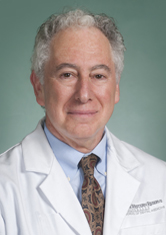
Case Western Reserve University School of Dental Medicine and the Department of Otolaryngology at University Hospitals Case Medical Center will collaborate on a pilot study to examine whether an abundance of naturally occurring antibacterial proteins in the mouth can predict the development of oral cancers.
The researchers will investigate how high levels of human beta-defensin-3 (hBD-3) in saliva and pre-cancerous tissues can be used to detect oral cancers faster and less invasively than traditional methods, said Aaron Weinberg, associate dean and chair of the Department of Biological Sciences at the School of Dental Medicine. They have found elevated levels of this protein in precancerous lesions and some oral cancers, which may provide early identification of these frequently asymptomatic cancers.
The hBD-3 peptide, which is found in the epithelial lining of the mouth, acts as a natural antibiotic in the body’s immune system. HBD-3 prevents the estimated 700 species of bacteria as well as viruses and fungi that live in the mouth from invading the body and causing disease.
The researchers will recruit 60 participants seeking treatment at UH Case Medical Center for possible oral cancers. They are also interested in patients with human papilloma virus (HPV), as this virus is increasingly correlated with increased incidence of head and neck cancer.
The researchers have found that hBD-3 is overexpressed in the early stage of HPV and non-HPV related head and neck cancers. Weinberg’s lab has developed an assay to measure hBD-3 levels in saliva, serum and tissue samples.
Weinberg, the study’s lead investigator, will work with co-investigator Chad Zender, from University Hospitals Case Medical Center’s ENT Institute, to elucidate the role of hBD-3 in the development of HPV and non-HPV associated head and neck cancer.
“HBD-3 has great potential as an important biomarker for cancerous lesions in the oral cavity,” Zender said. “This protein has the potential to help us predict which lesions are non-cancerous versus those that are malignant. If we can identify which lesions are more aggressive, this could have a big impact on cure rates for this type of cancer.”
The researchers hope to find a way to diagnose oral cancers in the earliest, more treatable stages, and to eventually halt cancer growth once diagnosed.
For years, researchers thought hBDs were “the good guys” in the mouth, said Weinberg, “but we are finding it isn’t always so.” The recent discovery by Case Western Reserve dental researcher and additional co-investigator Ge Jin has shown this not to be the case.
In tissue studies, Jin reported the disappearance of hBD-2, another innate peptide in the mouth’s lining that protects against microbial challenges, and the proliferation of hBD-3 in cancerous tissues.
The finding led the dental researchers to hypothesize that an abundance of hBD-3 in saliva and tissue might be a way to diagnose oral cancers.
“Our team recently found that the HPV type most implicated in head and neck cancer promotes hBD-3 overexpression,” Weinberg said.
Zender, a head and neck surgeon who treats benign and cancerous lesions of the mouth and throat, heard about Weinberg’s interest in studying the hBD-3 connection to cancer. The collaboration was forged during a meeting between Weinberg and Cliff Megerian, the chair of the Department of Otolaryngology.
Their study includes several components:
- Saliva samples will be collected and hBD-2 and hBD-3 levels will be measured to determine the ratio of the two peptides.
- An oral rinse will capture the presence of HPV to conduct genetic testing to find out which genotypes are present in the patient’s saliva. There are over 100 types of HPV that have been identified. Currently HPV 16 is the genotype most commonly associate with cancers of the head and neck.
- Ratios of hBD-2 to hBD-3 in normal and lesional sites of the same patient will be determined by collecting cells by using a cone-shaped cytobrush swab.
- Biopsies of questionable lesions will be taken to provide a diagnosis.
The researchers hope to determine the ratio of hBD-2 to hBD-3 that differentiates cancerous lesions from normal tissue, and may, one day be used as a diagnostic tool for oral cancers, Weinberg said.
”Our work will allow for a better understanding of the role hBD-3 plays in the development of head and neck cancer, and help with the prompt identification and treatment of patients with oral squamous cell carcinoma,” Zender said. “Our current understanding of oral cancer indicates that earlier diagnosis results in better outcomes.”
